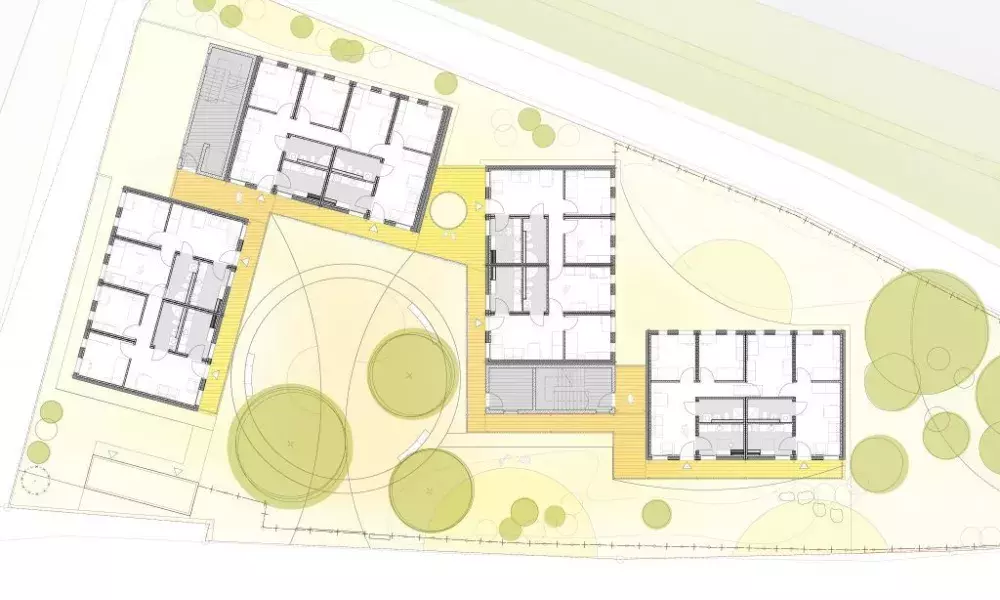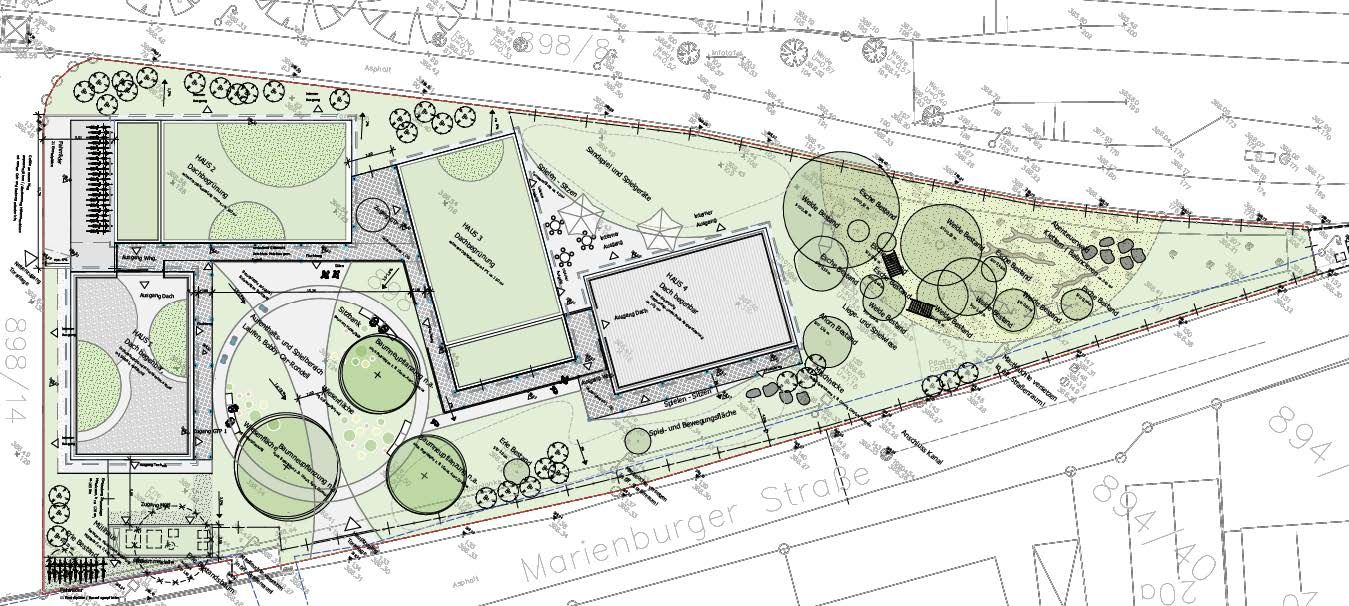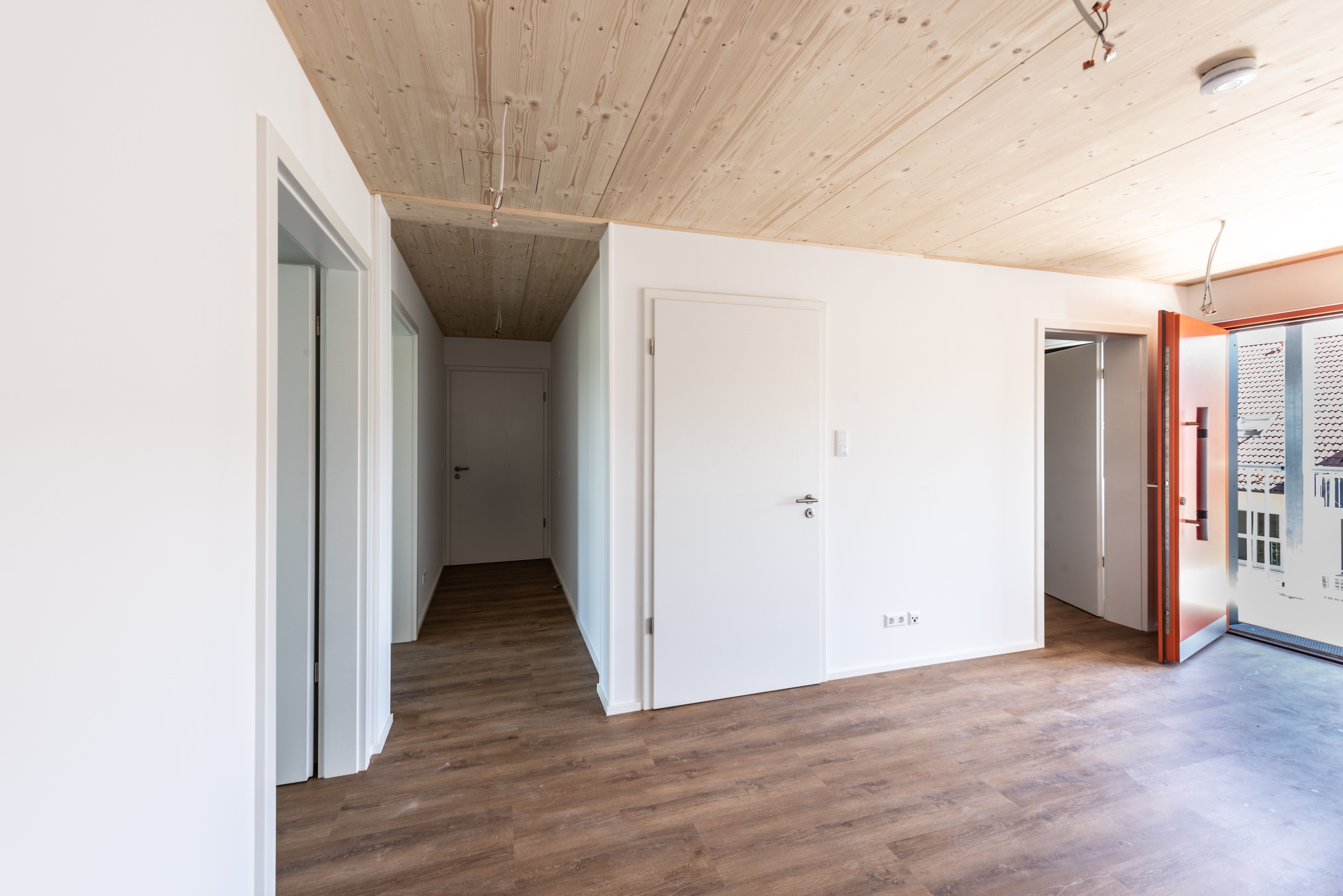Welcome to the new home – An introduction to the new "home & care" building

The goal for the new “home and care building” is to be a home for families and at the same time to guarantee childcare outside usual opening hours. This web article explains how this new home has been designed and the idea behind it.
1. A brief introduction to the new "home & care" building
The pilot project has found an excellent location thanks to the plot of land of the Hl. Geistspitalstiftung in Marienburger Straße - with shopping, schools, childcare and leisure facilities within walking distance, as well as short distances between living and working for everyone involved. The location is also ideal for those who do not have a car at their disposal. It is a 15-minute walk to the city center and the bus stop "Karlsbader Straße" is in the immediate vicinity. Line 7 takes you to the old town in a few minutes, and from there numerous lines provide fast and regular connections. The relatively flat, approx. 2410 m², triangular plot of land is located in the city of Landshut, approx. 1.5 km northeast of the old town. It borders on the banks of the small Isar river, previously a sports field, and offers the project a wide-ranging neighborhood. In order to provide the children and residents with the largest possible open space and play area on the property, the twelve required parking spaces have been relocated to the neighboring property.
The building is made up of four houses. In each case, two units have been grouped closer together by opening up the core. This results in two building sections that are linked via arcades to enable emergency escape routes that can be used from both sides via both stairwells.

Houses 1, 2 and 3 are grouped together to form a courtyard, which can be used as a central access point, but also as a communal space, both for the large day care center (play area) and for the residents (events). House 4 connects perpendicularly to the corner of house 3 and together with it defines the play area facing the small Isar river, which is adjacent to the existing small wood. All houses have rooms for the large day care on the first floor.
Houses 1 and 4 have residential units on two floors above. Houses 2 and 3 have one more residential floor, so that the middle houses are planned as four-story buildings and the peripheral buildings as three-story buildings.
Both the large day-care centers and the apartments are made up of modules of approximately 3.50 x 9.00 m. The level of each building has four modules. In total, the building consists of 56 modules. The two unheated cores which are opened up have been planned as a massive structure of reinforced concrete. The staircase between house 1 and house 2 has an elevator for vertical barrier-free access. The flat roofs of houses 2 and 3 will be set up for the installation of a PV system. House 1 and 4 will be extensively greened. The separately standing arcades are constructed with steel columns and connected via frames in which precast concrete elements are inserted. Fall protection is provided by steel railing elements stretched between the arcade supports. The facade is a pre-greyed plank wood formwork, which is mounted on a timber structure with insulation and sarking membrane. The windows will be triple-pane insulated plastic glazing with electric shutters. The building is made of serially prefabricated complete room modules made of solid wood, according to the principle of "plug & play". The individual components are combined to form multifunctional, flexible living units. Wood as a building material ensures a closed material cycle due to its complete recyclability. The modules are completely prefabricated in cross laminated timber (BSP). All defined fixtures and finishes such as sanitary wet cells, windows, sun protection, doors, floor construction, building services, lighting, etc. were installed at the factory.
The pilot project has found an excellent location thanks to the plot of land of the Hl. Geistspitalstiftung in Marienburger Straße - with shopping, schools, childcare and leisure facilities within walking distance, as well as short distances between living and working for everyone involved. The location is also ideal for those who do not have a car at their disposal. It is a 15-minute walk to the city center and the bus stop "Karlsbader Straße" is in the immediate vicinity. Line 7 takes you to the old town in a few minutes, and from there numerous lines provide fast and regular connections. The relatively flat, approx. 2410 m², triangular plot of land is located in the city of Landshut, approx. 1.5 km northeast of the old town. It borders on the banks of the small Isar river, previously a sports field, and offers the project a wide-ranging neighborhood. In order to provide the children and residents with the largest possible open space and play area on the property, the twelve required parking spaces have been relocated to the neighboring property.
The building is made up of four houses. In each case, two units have been grouped closer together by opening up the core. This results in two building sections that are linked via arcades to enable emergency escape routes that can be used from both sides via both stairwells.

Houses 1, 2 and 3 are grouped together to form a courtyard, which can be used as a central access point, but also as a communal space, both for the large day care center (play area) and for the residents (events). House 4 connects perpendicularly to the corner of house 3 and together with it defines the play area facing the small Isar river, which is adjacent to the existing small wood. All houses have rooms for the large day care on the first floor.
Houses 1 and 4 have residential units on two floors above. Houses 2 and 3 have one more residential floor, so that the middle houses are planned as four-story buildings and the peripheral buildings as three-story buildings.
Both the large day-care centers and the apartments are made up of modules of approximately 3.50 x 9.00 m. The level of each building has four modules. In total, the building consists of 56 modules. The two unheated cores which are opened up have been planned as a massive structure of reinforced concrete. The staircase between house 1 and house 2 has an elevator for vertical barrier-free access. The flat roofs of houses 2 and 3 will be set up for the installation of a PV system. House 1 and 4 will be extensively greened. The separately standing arcades are constructed with steel columns and connected via frames in which precast concrete elements are inserted. Fall protection is provided by steel railing elements stretched between the arcade supports. The facade is a pre-greyed plank wood formwork, which is mounted on a timber structure with insulation and sarking membrane. The windows will be triple-pane insulated plastic glazing with electric shutters. The building is made of serially prefabricated complete room modules made of solid wood, according to the principle of "plug & play". The individual components are combined to form multifunctional, flexible living units. Wood as a building material ensures a closed material cycle due to its complete recyclability. The modules are completely prefabricated in cross laminated timber (BSP). All defined fixtures and finishes such as sanitary wet cells, windows, sun protection, doors, floor construction, building services, lighting, etc. were installed at the factory.
2. The idea behind the construction

From the beginning of the project, it was clear that only a new building could create the conditions for implementing the project idea of "next door". The challenge was to place two identical apartments next to each other in such a way that the caregiver’s room could be accessed from both apartments. This allows that the child does not need to wake up when his mother has to go to work early in the morning, during night or weekend shifts. The child can be woken up and get ready for the day by the childminder who lives next door with her child.
It was decided that 20 apartments and 4 large day care centers (GTP) would be built. The plot of lands allowed to build day care centers separated from the others, so that each GTP can be run autonomously with independent childminders who take care of the children. Thus, the garden needed to be also spatially separated or used at different times. In addition, a GTP should have about 100 square meters for the care of up to 10 children. The necessary room requirements are defined by the Office for Child Day Care.
On the other hand, the dimensions of the rooms were predetermined by the maximum modular building dimensions - about 3.5 x 9 m, the size which is big enough to fit on a truck.
Due to the shape of the plot and taking the building standards into consideration, there were not many possibilities to distribute the building mass.
The solution with the formation of two courtyards seemed to be the best for the integration into the surroundings, as well as optimal for the use of the GTPs. The apartments had to be accessed from the outside and thus the arcade offers the possibility to connect all houses with each other. At the same time, it guarantees a high-quality recreation area and promotes communication as well as interaction between the residents of the complex.
In addition, the building concept allows for a low sealing of the surrounding open spaces, a near-natural design, as well as provides the opportunity for a variety of uses.
With this implementation of the idea, the residents now have a new home. They have already settled in and are in the process of organizing their life together. More information on this will be provided in the next web article. Currently, 20 families with 24 children live in the "home & care" building. There are 16 only children and 8 siblings. 7 children are of crèche age, 5 attend kindergarten and 12 attend school. 15 of the 20 families have a migration background. In the large day care centers 10 children from the house and 22 children from families in the neighborhood are cared for. This is a particularly important fact, as it means that the children and their parents from the neighborhood are also addressed and involved.

From the beginning of the project, it was clear that only a new building could create the conditions for implementing the project idea of "next door". The challenge was to place two identical apartments next to each other in such a way that the caregiver’s room could be accessed from both apartments. This allows that the child does not need to wake up when his mother has to go to work early in the morning, during night or weekend shifts. The child can be woken up and get ready for the day by the childminder who lives next door with her child.
It was decided that 20 apartments and 4 large day care centers (GTP) would be built. The plot of lands allowed to build day care centers separated from the others, so that each GTP can be run autonomously with independent childminders who take care of the children. Thus, the garden needed to be also spatially separated or used at different times. In addition, a GTP should have about 100 square meters for the care of up to 10 children. The necessary room requirements are defined by the Office for Child Day Care.
On the other hand, the dimensions of the rooms were predetermined by the maximum modular building dimensions - about 3.5 x 9 m, the size which is big enough to fit on a truck.
Due to the shape of the plot and taking the building standards into consideration, there were not many possibilities to distribute the building mass.
The solution with the formation of two courtyards seemed to be the best for the integration into the surroundings, as well as optimal for the use of the GTPs. The apartments had to be accessed from the outside and thus the arcade offers the possibility to connect all houses with each other. At the same time, it guarantees a high-quality recreation area and promotes communication as well as interaction between the residents of the complex.
In addition, the building concept allows for a low sealing of the surrounding open spaces, a near-natural design, as well as provides the opportunity for a variety of uses.
With this implementation of the idea, the residents now have a new home. They have already settled in and are in the process of organizing their life together. More information on this will be provided in the next web article. Currently, 20 families with 24 children live in the "home & care" building. There are 16 only children and 8 siblings. 7 children are of crèche age, 5 attend kindergarten and 12 attend school. 15 of the 20 families have a migration background. In the large day care centers 10 children from the house and 22 children from families in the neighborhood are cared for. This is a particularly important fact, as it means that the children and their parents from the neighborhood are also addressed and involved.
About this resource
The Urban Innovative Actions (UIA) is a European Union initiative that provided funding to urban areas across Europe to test new and unproven solutions to urban challenges. The initiative had a total ERDF budget of €372 million for 2014-2020.
Similar content




